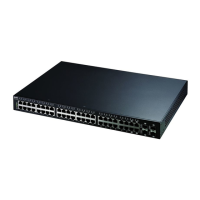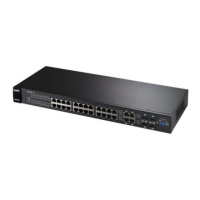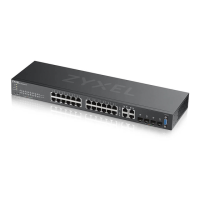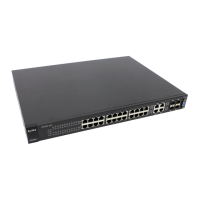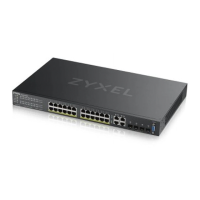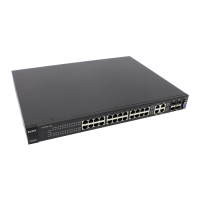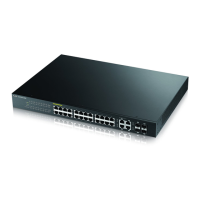
Do you have a question about the ZyXEL Communications GS2210-48HP and is the answer not in the manual?
| Brand | ZyXEL Communications |
|---|---|
| Model | GS2210-48HP |
| Category | Switch |
| Language | English |
Learn methods for managing the switch, including Web Configurator, CLI, FTP, and SNMP.
Follow best practices for secure and effective switch management, including password policies and backups.
Step-by-step guide for placing the switch on a desktop for proper setup and ventilation.
Instructions for securely mounting the switch in a standard 19-inch rack using provided brackets.
Describes the components visible on the front panel of the switch, including ports and LEDs.
Details the components on the rear panel, such as console port and power connector.
Explains the status and function of various LEDs on the switch for monitoring.
Steps to access the switch's web interface using a browser and default credentials.
Overview of the initial status screen displaying device information, system status, and IP addresses.
Recommended procedure to change the default administrator password for enhanced security.
Guide on how to save configuration changes permanently to the switch's non-volatile memory.
Guide on how to reload the factory default configuration file to reset the switch.
Steps to create a VLAN and assign ports to it for network segmentation.
How to set or change the switch's management IP address for network access.
A step-by-step guide to configure DHCPv4 snooping for enhanced network security.
Tutorial on configuring the switch to forward DHCP client requests to a specific DHCP server.
View general device information, system status, and IP addresses on the status screen.
Displays a port statistical summary with links to detailed port statistics.
Check firmware version and view general system information on the switch.
Configure general settings like system name, time, and time zone.
Configure global switch parameters like VLAN type and priority queues.
Configure the switch IP address, default gateway, and management VLAN ID.
Configure individual switch port settings such as speed, duplex, and flow control.
View and manage Power over Ethernet (PoE) status and priority levels for connected devices.
Configure IPv6 settings, including interface status and addresses.
Configure IEEE 802.1Q tagged and port-based VLAN parameters for the switch.
Create and configure static VLANs to group traffic based on port membership.
Set static VLAN (IEEE 802.1Q) parameters for individual ports.
Group traffic into VLANs based on source IP subnet for traffic classification.
Set up VLANs where packet forwarding is based on destination MAC address and associated port.
Manually enter static MAC addresses in the table to control frame forwarding and enhance port security.
Configure rules to forward specific multicast frames to designated ports within a VLAN group.
Create rules for traffic filtering based on source/destination MAC addresses and VLAN group ID.
Activate and configure Spanning Tree Protocol modes (RSTP, MRSTP, MSTP) to prevent network loops.
Configure Rapid Spanning Tree Protocol (RSTP) settings for faster network loop prevention.
Configure Multiple Rapid Spanning Tree Protocol (MRSTP) for managing multiple spanning trees.
Configure Multiple Spanning Tree Protocol (MSTP) settings for enhanced network resilience.
Configure maximum allowable bandwidth limits for incoming and outgoing traffic flows on ports.
Limit broadcast, multicast, and DLF packets per second to prevent network storms.
Configure port mirroring to copy traffic flow to a monitor port for analysis without interference.
Configure static link aggregation by selecting traffic distribution algorithms and grouping ports.
Enable Link Aggregation Control Protocol (LACP) for dynamic link aggregation.
Activate port authentication methods and configure RADIUS server settings for user validation.
Enable IEEE 802.1x security to authenticate clients using username and password.
Configure a guest VLAN for providing limited network access to unauthenticated users.
Activate MAC authentication to validate client access based on MAC address and password.
Enable port security to allow only authorized MAC addresses to pass through a port.
Define one-time or recurring schedules for time-oriented features like PoE and classifiers.
Define classifiers to group traffic based on specific criteria and specify actions for classified flows.
Configure match order and enable logging for classifier rules.
An example illustrating how to configure a classifier to identify traffic based on MAC address and port.
Configure policy rules to ensure classified traffic flows receive the requested network treatment.
An example demonstrating how to configure a policy to limit bandwidth on a traffic flow.
Understand queuing algorithms like SPQ, WFQ, and WRR for traffic management.
Set priorities for traffic queues to distribute bandwidth across different traffic flows.
Configure IPv4/IPv6 multicast settings and set up multicast VLANs.
View IPv4 multicast group information and IGMP snooping status.
Configure IGMP snooping to forward group multicast traffic efficiently.
View IPv6 multicast group information and MLD snooping status.
Configure MLD snooping-proxy to minimize control messages and improve network performance.
Create multicast VLANs and select receiver/source ports for each multicast VLAN.
Access screens to enable and configure AAA settings for authentication and authorization.
Configure settings for RADIUS servers used for authentication and authorization.
Configure settings for TACACS+ servers used for authentication and authorization.
Configure authentication, authorization, and accounting methods and priority.
Understand how IP source guard filters unauthorized DHCP and ARP packets using a binding table.
View current bindings for DHCP snooping and ARP inspection.
Manage static bindings for DHCP snooping and ARP inspection by MAC address and VLAN ID.
Enable DHCP snooping, specify VLANs, and configure the DHCP snooping database.
Enable ARP inspection and configure logging settings for discarded ARP packets.
Manually create IPv6 source guard binding table entries and manage static bindings.
Configure policies to forward valid IPv6 addresses/prefixes and block traffic from link-local addresses.
Specify which ports are trusted or untrusted for DHCPv6 snooping.
Understand how loop guard prevents loops on the network edge by shutting down ports.
Enable loop guard on the switch and specific ports to detect and prevent network loops.
Learn how to configure layer 2 protocol tunneling to encapsulate packets for service provider networks.
Enable and configure layer 2 protocol tunneling, specifying MAC addresses for packet encapsulation.
Understand the PPPoE Intermediate Agent's role in providing subscriber information to PPPoE servers.
Configure the PPPoE Intermediate Agent globally on the switch.
Specify trusted/untrusted ports and configure agent sub-options on a per-port basis.
Configure PPPoE IA settings that apply to a specific VLAN on a port.
Enable PPPoE Intermediate Agent on a VLAN and configure Circuit ID/Remote ID.
Understand how the switch handles errors by disabling ports or dropping packets.
Limit the number of control packets (ARP, BPDU, IGMP) received or transmitted per port.
Detect control packet rate limits and configure actions when limits are exceeded.
Configure the switch to automatically undo actions after an error condition is resolved.
Learn how Private VLANs provide port isolation within a VLAN by specifying promiscuous and isolated ports.
Configure private VLAN rules to isolate ports within a VLAN, allowing communication only with promiscuous ports.
Understand how Green Ethernet features reduce switch port power consumption.
Enable Energy Efficient Ethernet (EEE), Auto Power Down, and Short Reach features to reduce power consumption.
Learn about LLDP for advertising device identity and capabilities on the local network.
View LLDP status summary for the switch, including chassis ID, system name, and port information.
View LLDP status information from neighboring devices connected to the switch.
Configure global LLDP settings, including transmit intervals and basic TLV options.
Configure LLDP-MED parameters for media endpoint devices, including network policy and location.
Define network policies for applications like Voice, Video, and Guest access using LLDP-MED.
Configure location information for remote devices using geographical coordinates and Civic Address.
Understand how Anti-Arpscan detects and blocks unusual ARP scan activity to prevent attacks.
Check which ports are trusted, forwarding traffic, or are disabled due to ARP inspection.
View blocked hosts and unblock connected devices identified by IP address or MAC address.
Create or remove trusted hosts to exempt them from Anti-Arpscan analysis.
Enable Anti-Arpscan, set port/host thresholds, and configure port trust states.
Learn how BPDU Guard prevents unauthorized STP-aware switches from connecting and causing topology changes.
View the status of BPDU Guard globally and on a per-port basis.
Enable BPDU Guard on the switch and specific ports to automatically disable ports upon BPDU detection.
Understand Link Layer Ethernet OAM for link monitoring and troubleshooting network connections.
View the configuration of ports where Ethernet OAM is enabled.
Enable Ethernet OAM on the switch and ports, and configure related settings.
Perform remote loopback tests to verify link status and troubleshoot connectivity.
Understand how ZyXEL Unidirectional Link Detection (ZULD) detects and disables physical one-way links.
View details of unidirectional and bidirectional links discovered by ZULD.
Enable ZULD on ports, configure its mode, and set the probe time for unidirectional link detection.
Learn how to configure static routes for IP communication with remote management stations.
Configure and enable IPv4 static routes to define how the switch forwards traffic to specific destinations.
Understand Differentiated Services (DiffServ) for prioritizing traffic and managing network quality.
Activate DiffServ to apply marking rules or IEEE 802.1p priority mapping.
Configure the mapping between DSCP values and IEEE 802.1p priority levels for traffic prioritization.
Learn how DHCP allows computers to obtain TCP/IP configuration and how the switch can act as a relay agent.
Access screens to enable and configure DHCPv4 relay and option 82 profiles.
View the current DHCP relay mode and status of the switch.
Configure DHCP relay settings to forward network information between clients and servers.
Add source information to client DHCP requests to aid server authentication and IP assignment.
Create DHCPv4 option 82 profiles to include specific information in relay agent requests.
Configure global DHCPv4 relay settings to forward all requests to the same server.
Configure DHCP settings based on the VLAN domain of DHCP clients for per-VLAN relay.
Enable and configure DHCPv6 relay settings for specific VLANs on the switch.
Understand the Address Resolution Protocol (ARP) for mapping IP addresses to MAC addresses and the ARP table.
Configure ARP learning modes per port to manage the ARP table and prevent spoofing.
Set the ARP learning mode (ARP-Reply, Gratuitous-ARP, ARP-Request) for each port.
Access the maintenance screen to manage firmware and configuration files.
Reset the switch configuration to factory defaults to clear all settings.
Save current configuration settings permanently to Configuration 1 or Configuration 2.
Upgrade the switch firmware to the latest version using the web configurator.
Restore a previously saved configuration file from a computer to the switch.
Save current device settings to a computer for later use or restoration.
Use the Tech-Support feature for log enhancement and issue analysis by customer support.
Understand methods for controlling access to the switch via console, Telnet, SSH, FTP, and SNMP.
Access the main screen to configure access control settings.
Configure SNMP settings, including version, community strings, and trap destinations.
Configure administrator and user accounts for accessing the switch via the web configurator.
Decide which services (Telnet, SSH, FTP, etc.) can be used to access the switch.
Specify trusted computers that can manage the switch remotely using various services.
Use the diagnostic screen to perform ping tests, traceroutes, port tests, and view switch location.
Check current system logs, refresh the view, clear logs, or download log files.
Configure device logging settings and a list of external syslog servers.
Learn how to manage multiple switches as a single unit through a cluster manager.
View the role of the switch within the cluster and access cluster member switches' web configurators.
Configure cluster management settings, including defining the cluster manager and members.
Understand how the MAC table (filtering database) shows frame forwarding across switch ports.
Check whether MAC addresses are dynamic or static and view port forwarding information.
Understand the ARP protocol for mapping IP addresses to MAC addresses and the ARP table.
View IP-to-MAC address mappings and remove dynamic ARP entries.
Learn about Path MTU Discovery for determining the maximum transmission unit across network paths.
View IPv6 path MTU information on the switch.
Copy basic and advanced settings from a source port to destination ports for efficient configuration.
Understand the IPv6 neighbor table for resolving and verifying IPv6 addresses.
View IPv6 neighbor information on the switch, including addresses and MAC addresses.
Troubleshoot issues related to power, hardware connections, and LED indicators.
Resolve problems with accessing the switch via IP address, username, or password.
Troubleshoot issues related to losing configuration settings after restarting the switch.
Lists essential information to have ready when contacting customer support for assistance.
Lists common network services, their protocols, port numbers, and descriptions.
Explains IPv6 address structure, abbreviations, and examples.
Understand how IPv6 devices can automatically generate unique IP addresses without a DHCP server.
Explains the DHCPv6 protocol for assigning IPv6 addresses and configuration information.
Describes the NDP protocol used to discover IPv6 devices and track neighbor reachability.
Contains copyright information for the publication and ZyXEL Communications Corporation.
Outlines ZyXEL's liability and rights regarding product application and software described herein.
Lists registered trademarks of ZyXEL Communications, Inc. and other mentioned trademarks.
Provides regulatory compliance information for product usage in different regions.

